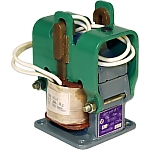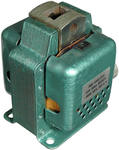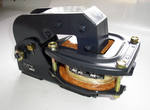Comparison of DC and AC Solenoids
Compare electromagnets alternating current with direct current electromagnets. Such a comparison will make it possible to determine the appropriate fields of application for each of these types of electromagnets.
Traction force of electromagnets
For a given cross-sectional area of the poles that form the working air gap, the average force in the AC electromagnet will be half the force in the DC electromagnet. This applies equally to single-phase and multi-phase systems. In other words, the use of steel in an AC electromagnet is at least 2 times worse than in a DC electromagnet.
A mass of electromagnets
 For a given grip force and armature stroke, the alternating current electromagnet turns out to have a significantly larger mass than the direct current electromagnet, since it is necessary to take at least twice as much steel and significantly increase the volume of copper due to the fact that that a certain amount of power is required.
For a given grip force and armature stroke, the alternating current electromagnet turns out to have a significantly larger mass than the direct current electromagnet, since it is necessary to take at least twice as much steel and significantly increase the volume of copper due to the fact that that a certain amount of power is required.
Minimum reactive power required.It is consumed by an AC electromagnet during its activation reactive power is uniquely related to the amount of mechanical work required of that electromagnet and cannot be reduced by increasing its size. In direct current electromagnets there is no such relationship, and if the question of speed of action is not affected, then power consumption can be reduced with a corresponding increase in size.
Speed of electromagnets
 AC electromagnets are fundamentally faster than conventional DC electromagnets. This is due to the fact that their electromagnetic time constant is usually commensurate with the value of one period of alternating current and e. etc. c. the self-induction resulting from the movement of the armature is significantly lower than the applied voltage.
AC electromagnets are fundamentally faster than conventional DC electromagnets. This is due to the fact that their electromagnetic time constant is usually commensurate with the value of one period of alternating current and e. etc. c. the self-induction resulting from the movement of the armature is significantly lower than the applied voltage.
In permanent electromagnets, the response time can be reduced by special measures, which amount to reducing the ratio of self-induction voltage to applied voltage, reducing eddy currents, etc. All this ultimately leads to an increase in electricity consumption, however, as a general rule, for the same output work and the same operating times, a DC electromagnet usually has lower power consumption than an AC electromagnet.
Effect of eddy currents
Due to the need to prevent the occurrence of excessive eddy current losses, the magnetic circuits of alternating current electromagnets must be laminated or separated, while in direct current this is only required for high-speed electromagnets.
This design of the magnetic circuit leads to deterioration of the volume filling with steel, and also predetermines the prismatic shape of the parts of the magnetic circuit. The latter causes an increase in the length of the average turn of the coil and leads to some structural and technological disadvantages.
The losses continue eddy currents, as well as the reversal of the magnetization leads to an increase in the heating of the electromagnet. In direct current electromagnets, all the above limitations disappear.
Areas of application of DC and AC electromagnets
 In conventional stationary industrial installations fed by an alternating current (50 Hz) network of sufficient power, many of the above negative points are not an obstacle to the use of alternating current electromagnets.
In conventional stationary industrial installations fed by an alternating current (50 Hz) network of sufficient power, many of the above negative points are not an obstacle to the use of alternating current electromagnets.
The higher reactive power consumption at the beginning of the clock will not significantly affect other users. If at the end of the armature stroke of the electromagnet the air gaps are insignificant, the reactive power consumed when pulling the armature will be small.
